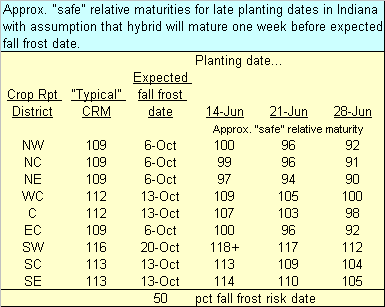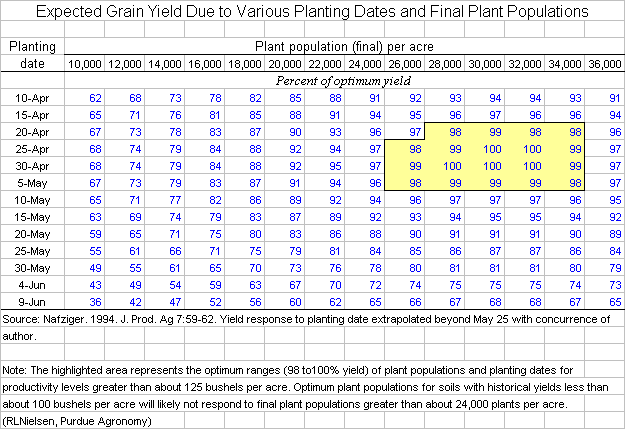Published 11 June 2008
URL: http://www.kingcorn.org/news/articles.08/FloodingReplant-0611.html
Replant Considerations for Flooded Corn
R.L. (Bob) Nielsen
Agronomy Dept., Purdue Univ.
West Lafayette, IN 47907-2054
Email address: rnielsen
at purdue.edu
![]() onded
or flooded crop fields in early to mid-June are not a desirable sight for
growers and ag. industry alike. Growers must decide on management options
that best minimize their potential losses in income and yield while the ag.
industry scrambles to meet the anticipated demand for replant seed and other
inputs required by their customers over the coming weeks. All of this falls
in the middle of the time period that is already busy with applications of
sidedress nitrogen and post-emergence herbicide.
onded
or flooded crop fields in early to mid-June are not a desirable sight for
growers and ag. industry alike. Growers must decide on management options
that best minimize their potential losses in income and yield while the ag.
industry scrambles to meet the anticipated demand for replant seed and other
inputs required by their customers over the coming weeks. All of this falls
in the middle of the time period that is already busy with applications of
sidedress nitrogen and post-emergence herbicide.
I and several of my colleagues at Purdue and elsewhere have addressed some of the key issues related to flooded crops (Johnson & Nice, 2008; Nielsen, 2008a; Nielsen et al., 2008; Pedersen, 2008a; Pedersen, 2008b; Shaner, 2008; Vyn, 2008). Let me address a few more issues specifically related to replanting options for flooded cornfields.
Crop Insurance Considerations
Growers who have purchased crop insurance and are interested in replanting damaged cornfields or parts of fields at this late date should first consult with their crop insurance agent to determine the ramifications of a replant decision on their insurance coverage or payout. Crop insurance policies can vary greatly in their impact on replant decisions farmers may make (Patrick, 2008).
Replanting Back to Corn
Replanting damaged cornfields back to corn is becoming an increasingly uncertain choice, especially for growers in the northern two-thirds of Indiana because of the rapidly shortening growing season and the prospects for significantly lower yield potential. Some folks, though, may feel obligated to replant to corn for various reasons (nitrogen already applied, herbicide already applied, landlord's insistence, etc.).
Tables 1 & 2 list the approximate "safe" relative hybrid maturities that could be planted over the coming weeks throughout Indiana. The two tables differ according to the date by which you want to target physiological maturity of the crop and its relationship to the date by which a killing fall frost typically occurs. Table 2 is more conservative; meaning that the listed hybrid maturities are earlier than those in Table 1 and thus will more likely mature safely prior to a killing frost this fall. See my earlier article for more background information on how these hybrid maturity estimates are determined (Nielsen, 2008b).
The challenge for many growers in this regard will be that the suggested hybrid maturities are less adapted to their areas of Indiana than normal full-season hybrids, especially in terms of disease resistance, and thus must be considered with great caution. Secondly, the seed availability of these early maturity hybrids will undoubtedly be limited and so growers ought to be talking with their seed dealers now if they anticipate replanting damaged areas.
Table 1.

Table 2.

One of the frustrating issues with making a replant decision this late in the season is that there is essentially no data-based information we can rely on to estimate yield potential for corn replanted in late June. The tabular information we usually rely on is that from the Univ. of Illinois (reproduced below in Table 3), but it only extends through the first week of June. Based on conversations with a number of colleagues, most of us believe that corn planted in late June would yield approximately 50% of that planted in "normal" planting periods (assuming the corn matures safely prior to a killing fall frost). However, coupled with current high corn grain prices, even that low of a yield prospect may be worth the risk for some growers.
Be aware that corn replanted late, especially if replanted into a flooded pocket within a field, will be very attractive to corn rootworm beetles during pollination. Growers should monitor such replanted areas near pollination and be prepared to apply foliar insecticides if warranted. One positive note is that, compared to the pre-biotech era, today's hybrids that carry the Bt-corn borer trait greatly reduce the yield-robbing effects of European or southwestern corn borer insects in late-planted corn.
Table 3.

Replanting Back to Soybean
Some growers will choose to forego replanting damaged cornfields back to corn in favor of replanting back to soybeans instead, even if they have already applied corn herbicides and/or nitrogen fertilizer. Recognize that while the choice to replant damaged cornfields back to soybeans is the prerogative of the grower, the risk of damage to the soybean crop from previously applied corn herbicides is borne solely by the grower because most soil-applied corn herbicides have more than a few months' crop rotation restriction on their labels (Johnson & Nice, 2008). Recognize that seed supply for replant soybean will also be in short supply. At the least, growers will likely not be able to purchase their first choice of a soybean variety.
Replanting Back to Grain Sorghum
Growers interested in replanting damaged cornfields to grain sorghum should consult the article we published recently (Nielsen et al., 2008). Please recognize, however, that if you have never before grown that crop, doing so under a crisis mindset may not be the best time to learn the ins and outs of that crop. I've also been told that seed supply of that crop will be in short supply.
Replanting Back to Summer Forage
Some growers may elect to replant damaged cornfields or parts of fields to one of several types of summer forage species to be harvested later to supplement anticipated shortages of normal forage supplies. Contact my forage colleague, Keith Johnson (johnsonk@purdue.edu), for more information on this opportunity.
Related References
Johnson, Bill and Glenn Nice. 2008. Considerations for Replanting Soybean in Drowned out Corn Fields. Purdue Extension Weed Science. [On-line]. Available at http://www.btny.purdue.edu/weedscience/2008/DrownedCorn08.pdf. [URL accessed 6/10/08].
Nielsen, R.L. (Bob). 2008a. Effects of Flooding or Ponding on Young Corn. Corny News Network, Purdue Extension. [On-line]. Available at http://www.kingcorn.org/news/timeless/PondingYoungCorn.html. [URL accessed 6/9/08].
Nielsen, R.L. (Bob). 2008b. Late Planting/Replanting & Relative Hybrid Maturity. Corny News Network, Purdue Extension. [On-line]. Available at http://www.kingcorn.org/news/2008/DelayedPlt_Hybrids.html. [URL accessed 6/11/08].
Nielsen, R.L. (Bob). 2008c. More Thoughts on Late Corn Planting. Corny News Network, Purdue Extension. [On-line]. Available at http://www.kingcorn.org/news/2008/DelayedPltUpdate-0523.html. [URL accessed 6/11/08].
Nielsen, R.L. (Bob), Bill Johnson, & Glenn Nice. 2008. Grain Sorghum Considerations for Late Planting in Southern Indiana. Corny News Network, Purdue Extension. [On-line]. Available at http://www.kingcorn.org/news/timeless/LatePlantGrainSorghum.html. [URL accessed 6/9/08].
Patrick, George. 2008. Decisions await farmers with crop insurance, economist says. Purdue Univ. News. [On-line]. Available at http://news.uns.purdue.edu/x/2008a/080610PatrickInsurance.html. [URL accessed 6/11/08].
Pedersen, Palle. 2008a. Effect of Flooding on Emerged Soybeans. Integrated Crop Management News, Iowa State Univ. [On-line]. Available at http://www.extension.iastate.edu/CropNews/2008/0531PallePedersen2.htm. [URL accessed 6/9/08].
Pedersen, Palle. 2008b. Soybean Replant Decisions from Hail Damage and Flooded Fields. Integrated Crop Management News, Iowa State Univ. [On-line]. Available at http://www.extension.iastate.edu/CropNews/2008/0531PallePedersen.htm. [URL accessed 6/9/08].
Shaner, Greg. 2008. Recent Weather May Promote Unusual Disease Problems in Corn. Corny News Network, Purdue Extension. [On-line]. Available at http://www.kingcorn.org/news/timeless/FloodingDisease-0610.html. [URL accessed 6/10/08].
Vyn, Tony. 2008. Tillage System Choices for June Planting or Replanting after Flooding. Corny News Network, Purdue Extension. [On-line]. Available at http://www.kingcorn.org/news/timeless/FloodingTillage-0610.html. [URL accessed 6/10/08].

